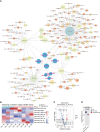Identification of SCRG1 as a Potential Therapeutic Target for Human Synovial Inflammation
- PMID: 35720295
- PMCID: PMC9204521
- DOI: 10.3389/fimmu.2022.893301
Identification of SCRG1 as a Potential Therapeutic Target for Human Synovial Inflammation
Abstract
Synovial inflammation of joint tissue is the most important cause of tissue damage, joint destruction, and disability and is associated with higher morbidity or mortality. Therefore, this study aims to identify key genes in osteoarthritis synovitis tissue to increase our understanding of the underlying mechanisms of osteoarthritis and identify new therapeutic targets. Five GEO datasets with a total of 41 normal synovial membrane tissues and 45 osteoarthritis synovial membrane samples were used for analysis, and seven common differential genes were identified. The classification model constructed by LASSO analysis showed that six genes including CDKN1A, FOSB, STMN2, SLC2A3, TAC, and SCRG1 can be used as biomarkers of osteoarthritis, and the SCRG1 gene shows importance in osteoarthritis. Furthermore, drug database enrichment found that these six DEGs may be the drug targets of synovitis in osteoarthritis, and Valproic Acid CTD 00006977 may be a potential targeted therapeutic drug of SCRG1. Spearman correlation analysis was performed on the SCRG1 gene, and 27 genes with consistent expression were obtained. Functional analysis showed that 27 genes were mainly involved in metabolism, complement, antigen presentation, apoptosis, and regulation of immune pathways. The co-regulatory network of TFs-miRNA suggested that the SCRG1 gene may be regulated by hsa-miR-363-3p miRNA. In conclusion, SCRG1, as a diagnostic marker of osteoarthritis, co-regulates immune-related pathways through the interaction of related proteins, playing an important role in the occurrence and development of osteoarthritis, which may be a novel drug target.
Keywords: LASSO; SCRG1; osteoarthritis; pharmaceutical therapy; synovium.
Copyright © 2022 Liu, He, Zhang, Zhang and Wang.
Conflict of interest statement
The authors declare that the research was conducted in the absence of any commercial or financial relationships that could be construed as a potential conflict of interest.
Figures





Similar articles
-
Genome-wide expression and methylation profiles reveal candidate genes and biological processes underlying synovial inflammatory tissue of patients with osteoarthritis.Int J Rheum Dis. 2015 Sep;18(7):783-90. doi: 10.1111/1756-185X.12643. Epub 2015 Jul 14. Int J Rheum Dis. 2015. PMID: 26171692
-
Identification of pathways and genes associated with synovitis in osteoarthritis using bioinformatics analyses.Sci Rep. 2018 Jul 3;8(1):10050. doi: 10.1038/s41598-018-28280-6. Sci Rep. 2018. PMID: 29968759 Free PMC article.
-
Identification of pivotal genes and pathways in the synovial tissue of patients with rheumatoid arthritis and osteoarthritis through integrated bioinformatic analysis.Mol Med Rep. 2020 Oct;22(4):3513-3524. doi: 10.3892/mmr.2020.11406. Epub 2020 Aug 3. Mol Med Rep. 2020. PMID: 32945465
-
Serum microRNA array analysis identifies miR-140-3p, miR-33b-3p and miR-671-3p as potential osteoarthritis biomarkers involved in metabolic processes.Clin Epigenetics. 2017 Dec 12;9:127. doi: 10.1186/s13148-017-0428-1. eCollection 2017. Clin Epigenetics. 2017. PMID: 29255496 Free PMC article.
-
Bioinformatics analysis to identify key genes and pathways influencing synovial inflammation in osteoarthritis.Mol Med Rep. 2018 Dec;18(6):5594-5602. doi: 10.3892/mmr.2018.9575. Epub 2018 Oct 23. Mol Med Rep. 2018. PMID: 30365099 Free PMC article.
Cited by
-
Therapeutic potential of Coptis chinensis for arthritis with underlying mechanisms.Front Pharmacol. 2023 Aug 11;14:1243820. doi: 10.3389/fphar.2023.1243820. eCollection 2023. Front Pharmacol. 2023. PMID: 37637408 Free PMC article. Review.
-
Comprehensive bulk and single-cell transcriptome profiling give useful insights into the characteristics of osteoarthritis associated synovial macrophages.Front Immunol. 2023 Jan 5;13:1078414. doi: 10.3389/fimmu.2022.1078414. eCollection 2022. Front Immunol. 2023. PMID: 36685529 Free PMC article.
-
New anti-diabetic drug Morus alba L. (Sangzhi) alkaloids (SZ-A) improves diabetic nephropathy through ameliorating inflammation and fibrosis in diabetic rats.Front Med (Lausanne). 2023 Jun 9;10:1164242. doi: 10.3389/fmed.2023.1164242. eCollection 2023. Front Med (Lausanne). 2023. PMID: 37359004 Free PMC article.
-
Exploring molecular mechanisms underlying the pathophysiological association between knee osteoarthritis and sarcopenia.Osteoporos Sarcopenia. 2023 Sep;9(3):99-111. doi: 10.1016/j.afos.2023.08.005. Epub 2023 Sep 15. Osteoporos Sarcopenia. 2023. PMID: 37941536 Free PMC article.
-
Bioinformatics Prediction and Experimental Validation Identify a Novel Cuproptosis-Related Gene Signature in Human Synovial Inflammation during Osteoarthritis Progression.Biomolecules. 2023 Jan 7;13(1):127. doi: 10.3390/biom13010127. Biomolecules. 2023. PMID: 36671512 Free PMC article.
References
-
- Collaborators G. B. D. R. F. Global, Regional, and National Comparative Risk Assessment of 84 Behavioural, Environmental and Occupational, and Metabolic Risks or Clusters of Risks for 195 Countries and Territories, 1990-2017: A Systematic Analysis for the Global Burden of Disease Study 2017. Lancet (2018) 392(10159):1923. doi: 10.1016/S0140-6736(18)32225-6 - DOI - PMC - PubMed
-
- Kroon FPB, Carmona L, Schoones JW, Kloppenburg M. Efficacy and Safety of non-Pharmacological, Pharmacological and Surgical Treatment for Hand Osteoarthritis: A Systematic Literature Review Informing the 2018 Update of the EULAR Recommendations for the Management of Hand Osteoarthritis. RMD Open (2018) 4(2):e000734. doi: 10.1136/rmdopen-2018-000734 - DOI - PMC - PubMed
MeSH terms
Substances
LinkOut - more resources
Full Text Sources
Medical
Molecular Biology Databases
Miscellaneous

